The Dropa Stone Discs
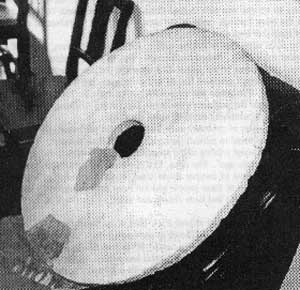
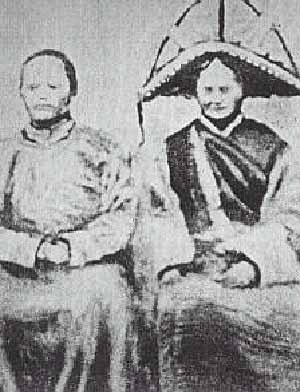
Who were the Dropa? The Dropa (also known as Dropas, Drok-pa or Dzopa) are, according to certain controversial writers, a race of dwarf-like extraterrestrials who landed near the Chinese-Tibetan border some twelve thousand years ago. Skeptics note, however, a number of problems with the case (and a lack of corroborative evidence), which offers significant doubt as to the reality of the more sensationalistic Dropa claims. Mainstream critics argue that the entire affair is a hoax.
Alleged Discovery -- Chi Pu Tei, a professor of archaeology at Beijing University, and his students were on an expedition to explore a series of caves in the pathless Himalayan mountains of the remote Bayan-Kara-Ula in Qinghai on the border of China and Tibet. The caves may have been artificially carved to be a system of tunnels and underground storerooms. The walls were squared and glazed, as if cut into the mountain with great heat.
They found many neat rows of tombs with short 4 ft 4 in inch skeletons buried within. The skeletons had abnormally big heads, and small, thin, fragile bodies. A member of the team suggested that these might be the remains of an unknown species of mountain gorilla. Prof. Chi Pu Tei was said to respond, "Who ever heard of apes burying one another?"
There were no epitaphs at the graves, but instead hundreds of one foot wide stone discs ("Dropa Stones") were found having 3/4 inch wide holes in their centers. On the walls were carved pictures of the rising sun, moon, stars, the land, mountains, and lines of pea-sized dots connecting the earth with the sky. Along with the discs, the cave drawings had been determined to be about 12,000 years old.
Photos of the Dropa Stones
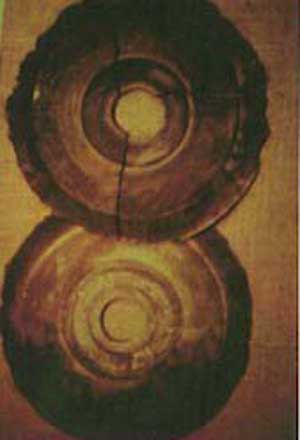

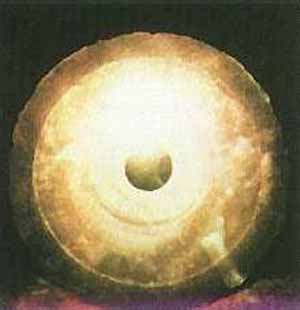
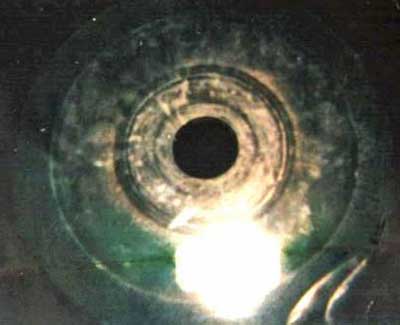
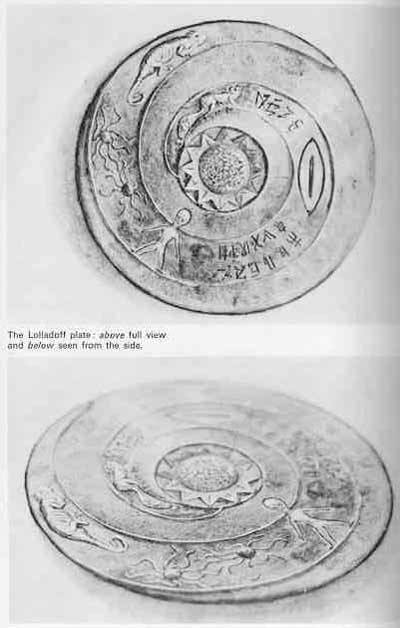
Each stone disk was reportedly inscribed with two fine grooves spiraling from
the edge to a hole in the disk's center, perhaps not unlike the Phaistos Disk.
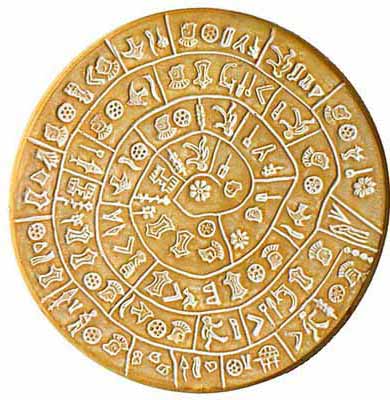
The disks were labeled along with other finds of the expedition and stored away at Beijing University for 20 years, during which deciphering attempts were unsuccessful. When the disks were closely examined by Dr. Tsum Um Nui of Beijing around 1958, he concluded that each groove actually consisted of a series of tiny hieroglyphs of unknown pattern and origin. The rows of hieroglyphics were so small that a magnifying glass was needed to see them clearly. Many of the hieroglyphics had been worn away by erosion. When Dr. Tsum deciphered the symbols, they told the story of the crash-landing of the Dropa spaceship and the killing of most of the survivors by local people.
According to Tsum Um Nui, one of the lines of the hieroglyphs reads, "The Dropas came down from the clouds in their aircraft. Our men, women and children hid in the caves ten times before sunrise. When at last they understood the sign language of the Dropas, they realized that the newcomers had peaceful intentions." Another section expresses "regret" by the Ham that the aliens' craft had crash-landed in such a remote and inaccessible mountain range and that there had been no way to building a new one to enable the Dropas to return to their own planet.
Dr. Tsum's report supposedly appeared in a professional journal in 1962. He was subsequently ridiculed to the point of self-imposed exile in Japan, where he died. The Peking Academy of Pre-history never allowed him to publish and never speak of his findings.
"Tsum Um Nui" is not a real Chinese name, and critics suggest that Dr. Tsum may not have actually existed. However Tsum Um Nui is a Japanese name adapted to Chinese language. There is no evidence of him beyond the Dropa allegations.
The records, some 716 grooved discs later uncovered in the same caves, tell an astonishing story of a space probe sent by the inhabitants of another planet. After landing at the Bayan-Kara-Ula mountain range, the scripts allegedly say, the peaceful intentions of the aliens confused the members of the Ham tribe, inhabitants of the neighboring caves, who hunted down and killed the extraterrestrials.
Photos claiming to show Dropa Disks are in fact Bi Disks, thousands of which have been found throughout China, mostly in the Southeastern Provinces. Bi Disks range in size of a few inches to several feet, and are most commonly made of jade or nephrite, with a round or square small central hole.
Most Bi Disks date to the Neolithic Period (c. 3000 BCE), but are found up to the Shang Dynasty Period. Bi Disks beyond the Shang Period are usually more ornate, carved with dragons, snakes and sometimes fish, and used in ritual ceremonies.
Most Neolithic Bi Disks were found in gravesites, buried beneath the head or feet of the deceased. It is theorized that this was to assist the deceased's spirit. No Bi Disks have been found to contain writing or spiral grooves as described in the Dropa story by authors such as Hartwig Hausdorf.
The Dropa Disks are said to be only 12 inches in diameter. However, one black and white photograph claimed by Hausdorf and others to display a Dropa Disk clearly shows the disk resting on a seat, and it is clearly several feet in diameter and has no markings whatsoever.
Wegerer asked the managers of Banpo-Museum for more information on the pieces in the showcase. The manager knew nothing of the stones' history, though she was able to tell a complete story about all the other artifacts made from clay. She only knew that the stone discs were unimportant "cult objects".
Wegerer was allowed to take one of the discs in his hand. He estimated their weight at 1 kilogram or 2 pounds, and the diameter at one foot. The hieroglyphs can't be seen in his photos, because they have crumbled away partly, and his camera's flash washed out the fine detail, such as the spiral grooves.
A few days after his visit, the manager was called away from her job without telling her why. She and the two stone discs vanished, according to Professor Wang Zhijun, the Director of the Banpo-Museum in March of 1994.
Legends supposedly still preserved in the area speak of small, gaunt, yellow-faced men who "came from the clouds, long, long ago". The men had huge, bulging heads and puny bodies and were so ugly and repellent that they were shunned by everyone. "Men with the quick horses" hunted down the ugly dwarfs. Strangely, the description of the "invaders" is said to match that of the skeletons originally discovered in the caves by Professor Chi Pu Tei.
No traceable, credible evidence for this theory exists, or can be proven to have existed in the past. Proponents of the Dropa-stones story claim that this is the result of social disruption caused by the Chinese Cultural Revolution and of a conspiratorial coverup by Chinese authorities. However this story goes well beyond China. Its opponents claim it is long proven to be a forgery by Erich von Daniken.
Below is a detailed rebuttal of most sensationalistic Extraterrestrial/Dropa claims:
- 1. The discovery. There are no mentions of 'Tsum Um Nui' anywhere; as he is supposed to have fled China and died in Japan in the 1960s this cannot be negated by Cultural Revolution, Communist coverup theory. Also, there is no mention of the 1938 archaeological expedition to the Banyan Kara Ulla range. No "Peking Academy of Pre-History" ever existed. 2. Early Sources. The earliest mention of the story is in Erich von Damien�s infamous 1968 book, Chariots of the Gods. The book has been widely criticized as unreliable; in fact, the vast majority of names and sources appearing in the book cannot be corroborated, and no existence of the following Soviet or Chinese scholars can be found anywhere outside this story: Cho Pu Tei, Tsum Um Nui, Ernst Wagener, Vyatcheslav Saizev, and Sergei Lolladoff. Most tellingly, D�niken gives his main source for the story as a Soviet science fiction writer Alexander Kazantsev; however Kazantsev himself disagrees with D�niken's account and says that it was D�niken who told him the story, not the other way around.
3. Later Sources. The 1978 book Sungods in Exile "edited" by David Agamon, appeared to lend support to the story of the Dropa, but Agamon admitted in the magazine Fortean Times in 1988 that the book was fiction and that its alleged author, a British researcher named Dr. Karyl Robin-Evans, was imaginary. Some websites claim to show a photo of Dr Robin-Evans with the Dalai Lama. A frail, old man assisted by the current Dalai Lama, the photograph is quite recent and can not be Dr Robin-Evans -- he died in 1978, according to Hartwig Hausdorf.
4. Translation. There is absolutely no precedent for an unknown language being successfully deciphered. All lost ancient languages have been rediscovered only because they survived in forms familiar to scientists. Even in such cases, deciphering and understanding these older language forms and their scripts has usually taken decades for multiple teams of highly competent linguists, and their findings are constantly being debated and updated. Many ancient scripts (notably Linear A from the island of Crete and Rongorongo from Easter Island), have defied deciphering precisely because they cannot be linked to any known language. Given these facts, there would be even greater difficulties in translating a truly extraterrestrial language. It is therefore highly unlikely that a single Chinese scholar with no reported background in linguistics could single-handedly decipher an alien script or language in his spare time.
5. The Disks. All that exists of the supposed alien disks are several wide-angle photographs. The disks photographed, firstly, do not match the described "12-inch disks"; the disks photographed are very large. Secondly, the photos show none of the supposed deep grooves. Finally, absolutely no photos, descriptions, analyses or any other evidence of the actual 'alien script' appear anywhere at all.
6. The Evidence. The disks were supposed to be stored in several museums in China. None of these museums have any traces of these disks, nor can any be found of the ones supposedly sent to USSR for analysis.
7. The Dropa Tribe. While reported to be a tribe of feeble dwarfs, in actuality the Dropas are nomadic herders who inhabit most of the northern Tibetan Plateau. The Ham are also inhabitants of Tibet, and traditionally have supplied Tibet's warriors: many of the 13th Dalai Lama's bodyguards during his escape from the Chinese invasion were Ham Tibetans. The word "Dropa", according to Chrieghton, describes the nomadic residents of Tibetan highlands, and can be roughly translated as "solitude" or "isolated". Furthermore, Chreighton described the Dropa as not resembling "troglodytes", or as stunted; on the contrary, they tend to be rather large and sturdy, befitting their occupation as herders. (Richie, 95-96)